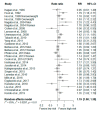Dietary Sodium Intake and Risk of Cardiovascular Disease: A Systematic Review and Dose-Response Meta-Analysis
- PMID: 32992705
- PMCID: PMC7601012
- DOI: 10.3390/nu12102934
Dietary Sodium Intake and Risk of Cardiovascular Disease: A Systematic Review and Dose-Response Meta-Analysis
Abstract
Dietary sodium intake has received considerable attention as a potential risk factor of cardiovascular disease. However, evidence on the dose-response association between dietary sodium intake and cardiovascular disease risk is unclear. Embase and PubMed were searched from their inception to 17 August 2020 and studies that examined the association between sodium intake and cardiovascular disease in adolescents were not included in this review. We conducted a meta-analysis to estimate the effect of high sodium intake using a random effects model. The Newcastle-Ottawa Scale assessment was performed. A random-effects dose-response model was used to estimate the linear and nonlinear dose-response relationships. Subgroup analyses and meta-regression were conducted to explain the observed heterogeneity. We identified 36 reports, which included a total of 616,905 participants, and 20 of these reports were also used for a dose-response meta-analysis. Compared with individuals with low sodium intake, individuals with high sodium intake had a higher adjusted risk of cardiovascular disease (Rate ratio: 1.19, 95% confidence intervals = 1.08-1.30). Our findings suggest that there is a significant linear relationship between dietary sodium intake and cardiovascular disease risk. The risk of cardiovascular disease increased up to 6% for every 1 g increase in dietary sodium intake. A low-sodium diet should be encouraged and education regarding reduced sodium intake should be provided.
Keywords: 24 h urinary sodium excretion; cardiovascular disease; cardiovascular mortality; dose-response meta-analysis; sodium intake.
Conflict of interest statement
The authors declare no conflict of interest.
Figures



References
-
- World Health Organization . Guideline: Sodium Intake for Adults and Children. World Health Organization; Geneva, Switzerland: 2012. - PubMed
-
- World Health Organization . Atlas of African Health Statistics 2018: Universal Health Coverage and the Sustainable Development Goals in the WHO African Region. World Health Organization; Geneva, Switzerland: 2018.
-
- World Health Organization . Global Health Risks: Mortality and Burden of Disease Attributable to Selected Major Risks. World Health Organization; Geneva, Switzerland: 2009.
-
- Powles J., Fahimi S., Micha R., Khatibzadeh S., Shi P., Ezzati M., Engell R.E., Lim S.S., Danaei G., Mozaffarian D. Global, regional and national sodium intakes in 1990 and 2010: A systematic analysis of 24 h urinary sodium excretion and dietary surveys worldwide. BMJ Open. 2013;3:e003733. doi: 10.1136/bmjopen-2013-003733. - DOI - PMC - PubMed
Publication types
MeSH terms
Substances
LinkOut - more resources
Full Text Sources
Medical

